
Edmond Eugène Alexis Rostand was a French poet and dramatist. He is associated with neo-romanticism and is known best for his 1897 play Cyrano de Bergerac. Rostand's romantic plays contrasted with the naturalistic theatre popular during the late nineteenth century. Another of Rostand's works, Les Romanesques (1894), was adapted to the 1960 musical comedy The Fantasticks.

Alectryon in Greek mythology, was a young soldier who was assigned by Ares, the god of war, to guard the outside of his bedroom door while the god took part in a love affair with the love goddess Aphrodite. Alectryon however failed at his job when he fell asleep, allowing Helios, the god of the Sun, to see the two lovers and alert Hephaestus, the husband of Aphrodite, thereupon Ares changed him into a rooster in anger, in an etiological myth that attempts to explain the origin of roosters and the reason why they crow each morning at dawn, warning of the Sun approaching. The myth is not mentioned by Homer, who first related the story of Ares and Aphrodite's infidelity in his Odyssey, but rather it was interpolated later by various authors.
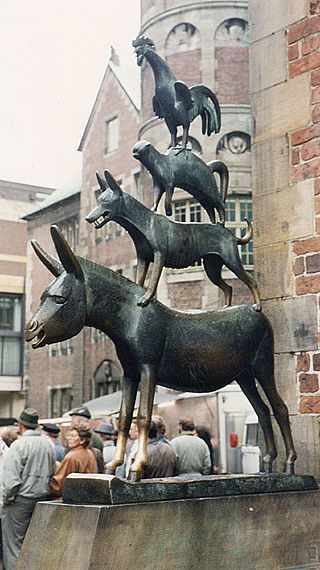
The "Town Musicians of Bremen" is a German fairy tale collected by the Brothers Grimm and published in Grimms' Fairy Tales in 1819.

"The Nun's Priest's Tale" is one of The Canterbury Tales by the Middle English poet Geoffrey Chaucer. Composed in the 1390s, it is a beast fable and mock epic based on an incident in the Reynard cycle. The story of Chanticleer and the Fox became further popularised in Britain through this means.

Benoît-Constant Coquelin, known as Coquelin aîné, was a French actor, "one of the greatest theatrical figures of the age."
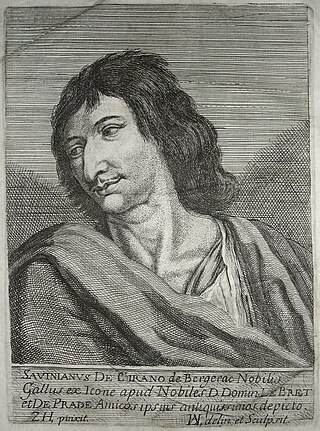
Cyrano de Bergerac is a play written in 1897 by Edmond Rostand. The play is a fictionalisation following the broad outlines of Cyrano de Bergerac's life.

Rock-a-Doodle is a 1991 independent live-action/animated musical comedy film produced by Sullivan Bluth Studios Ireland Limited and Goldcrest Films. Loosely based on Edmond Rostand's 1910 comedy play Chantecler, Rock-a-Doodle was directed by Don Bluth and written by David N. Weiss. The film features the voices of Glen Campbell, Christopher Plummer, Phil Harris, Charles Nelson Reilly, Sorrell Booke, Sandy Duncan, Eddie Deezen, Ellen Greene, and Toby Scott Ganger.

The Gallic rooster is a national symbol of France as a nation, as opposed to Marianne representing France as a state and its values: the Republic. The rooster is also the symbol of the Wallonia region and the French Community of Belgium.
Chanticleer and the Fox is a fable that dates from the Middle Ages. Though it can be compared to Aesop's fable of The Fox and the Crow, it is of more recent origin. The story became well known in Europe because of its connection with several popular literary works and was eventually recorded in collections of Aesop's Fables from the time of Heinrich Steinhowel and William Caxton onwards. It is numbered 562 in the Perry Index.
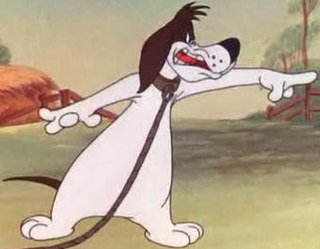
Barnyard Dawg is a Looney Tunes character. A feisty anthropomorphic basset hound, he is a friend and the archenemy of Foghorn Leghorn. He was created by Robert McKimson, who also created Foghorn, and was voiced by Mel Blanc. Dawg also feuds with other enemies as well like Henery Hawk, Daffy Duck and Sylvester. He appeared in 23 Golden Age–era Warner Bros. shorts.

Cyrano is an opera in four acts composed by Walter Damrosch to an English language libretto by William James Henderson based on Edmond Rostand's 1897 play, Cyrano de Bergerac. It premiered at the Metropolitan Opera in New York City on February 27, 1913, with Pasquale Amato in the title role and Frances Alda as Roxane.
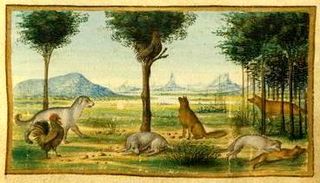
The Cock, the Dog and the Fox is one of Aesop's Fables and appears as number 252 in the Perry Index. Although it has similarities with other fables where a predator flatters a bird, such as The Fox and the Crow and Chanticleer and the Fox, in this one the cock is the victor rather than victim. There are also Eastern variants of this story.
Mother Pluto is a Silly Symphonies cartoon released on November 14, 1936, directed by Wilfred Jackson. The cartoon features Pluto.

Cock o' the Walk is a Silly Symphonies animated Disney short film. It was released in 1935.

Farmyard Symphony is a 1938 Silly Symphonies animated short film. It can be seen as a precursor to Fantasia due to using various pieces of classical music in one short. The film was directed by Jack Cutting and produced by Walt Disney.

Mickey's Follies is a Mickey Mouse animated short film first released on August 28, 1929, as part of the Mickey Mouse film series. It was directed by Ub Iwerks and Wilfred Jackson, with music by Carl Stalling. It was produced in black and white by The Walt Disney Studio and released to theaters by Celebrity Productions. It was the tenth Mickey Mouse short to be produced, the seventh of that year.
Golden Eggs is a 1941 American animated short film directed by Wilfred Jackson and produced by Walt Disney, featuring Donald Duck.
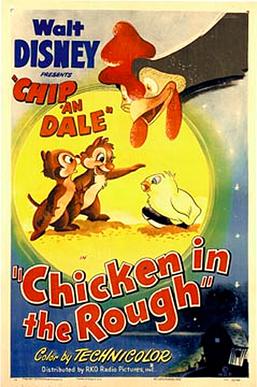
Chicken in the Rough is a 1951 animated short starring Chip 'n' Dale. It is Chip 'n' Dale's first solo cartoon together, and the footage is reused from the Silly Symphony short, Farmyard Symphony (1938). In the short film, Chip 'n' Dale wander into a farmyard to collect acorns. Dale mistakes an egg for a nut, but when he tries to demonstrate to a newly hatched chick how to get back into the egg, a rooster mistakes him for one of his chicks, much to Chip's amusement.














